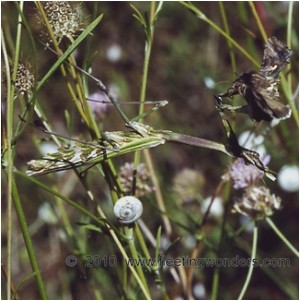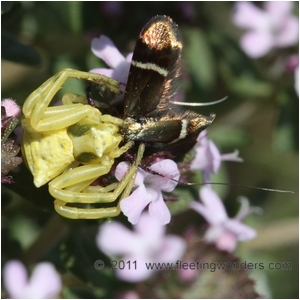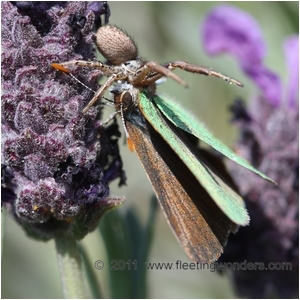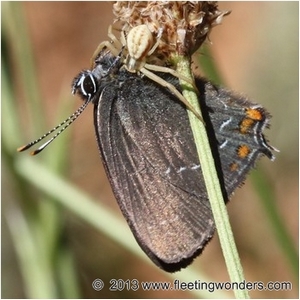 |  |  |
| Praying mantises (Order : Mantodea) are formidable predators for nectar-eating insects. They stay motionlessly on flower heads and wait patiently for an insect to come. The prey gets seized by the mantis which uses its pair of grasping-legs. | Left overs of a male of Adonis Blue (Lysandra bellargus) which is being eaten by a mantis. | This moth (Autographa gamma) has just been caught by a mediterranean mantis called 'Conehead Mantis' (Empusa pennata). Its colours make it invisible by preys or predators. |
| | | |
 |  |  |
| Crab spiders (spiders of Thomisidae family) have also colours that make them hard to spot (pinkish, brownish, yellowish or greenish depending on the species). They usually stand on flowers of the same tint and catch careless insects. After having pre-digested then sucked back the prey fluid, the spider drops its dead victim. |
| | | |
 |  |  |
| Other Crab spider having caught a Meadow Brown (Maniola jurtina) | Other Crab spider with a Dryad (Minois dryas) | Other Crab spider with a False grayling (Arethusana arethusa) |
| | | |
 |  |  |
| Synaema globosum, a typical spider of the mediterranean area waiting on a Centranthus ruber flower. The Scarce Swallowtail (Iphiclides podalirius) flew away when the spider rushed to seize it, but came back several times on the same flower without giving the impression to mind the spider. | Other spider which caught a Chapman's Green Hairstreak (Callophrys avis). |
| | | |
 |  |  |
| This burnet (Zygaena transalpina) was caught by a shieldbug (Pentatomidae family). Shieldbugs are insects whose mouthparts merge into a piercing/sucking rostrum that the bug uses for sucking the prey's fluids (or sap from plants). The victim is dropped after the meal. | Rhynocoris iracundus belongs to the Assassin Bugs group (Reduviidae family). It catches all kinds of insects such as this 6-spotted Burnet (Zygaena filipendulae) and sucks its content. |
| | | |
 |  | |
| A Conehead Mantis (Empusa pennata) which caught a Spotted Fritillary (Melitaea didyma) | A spider which caught an Ilex Hairstreak (Satyrium ilicis) | |
| | | |
| | | |
| | | |
| | | |
| | | |
| | | |
| | | |



















